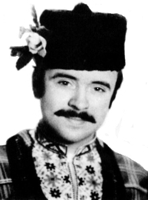
|
Folk Dance Federation of California, South, Inc.
|

|
CLICK AN IMAGE TO ENLARGE
I was Dennis Boxell's teaching assistant at Stockton Camp in 1967 when he taught Arap to the "Zajko Kokorajko" song. His notes say that the origin is Pirin-Macedonia (no specific source).
I also found syllabi in my files indicating that Dick Crum as well as Gordon Engler had taught it several years previously.
I first saw the multiple-figured dance done to "Zajko Kokorajko" music at the Intersection in Los Angeles. I learned the dance from Rubi Vučeta who used to teach this dance in Southern California. It had THREE figures (not 5 or 6). It did have a "Berovka" feeling and structure. When I asked her the name of the dance she said, folks here just call it Zajko Kokorajko but the real name is Skopsko Zaramo (shoulder hold dance from Skopje region). I liked the dance but realized it was confusing to people to have two sets of steps to the same music. I wanted to teach this dance back east, so I dug into my record collection and found a very similar song "Što Imala K'smet Stamena" sung by A. Sarievski to Pece Atanasovki's gajda and I remember teaching it at Columbia University in New York City in early 1968. It had a certain success then and some groups still do it. I also taught it in Chicago and other cities East of the Missisipi and I even have written notes for it. I never did find out the original source for this. Was it made up in California or from a Macedonian performing group? Only Rubi (bless her soul) may have the answer. I agree with Jane Sugarman that the steps are more East Macedonian and don't look like what you'd see in Skopje.
I have found in my Bulgarian book collection and notes several mention of the dance "Arap." Kostadin Ruitchev describes it in "Folklorni hora ot Pirinski Kraj" 1963 and the dance has often been part of choreographed suites for such groups as Pirin Ensemble (Ruitchev was choreographer of Pirin in early years). The dance according to him originates from Serres region (now in Greece). Jaap Leegwater did teach "Arap" in 1984 and has two nice recordings on his cassette JL 1984.02. One is played on zurna and tapan by musicians from Debren; the second one is by an ad hoc group from the Pirin Ensemble on bitovi instrumenti such as kaval, tambura, etc. Jaap says he learned the dance from Ivan Piperkov in Blagoevgrad in 1975 and later saw Kostadin Ruitchev teaching it at a seminar in Holland. If I remember well, Jaap taught it at a workshop in Vancouver, BC a few years back. The dance is very similar to the Crum-Boxell version. The music has that same slow heavy tempo.
The song "Zajko Kokorajko" is very famous all over Macedonia. The first recording is most likely Alexander Sarievski's (late 50's) on the old Jugoton EPY 3009 accompanied by the (young) Pece Atanasovski on gajda. The record was re-issued in the United States for folk dancers on several labels (Festival, Monitor, Mediterranean, etc.). Sarievski re-recorded at least two other versions with modern orchestras in the 60's and 70's. A collection of Macedonian Songs by V. Hadjimanov, Skopje 1964 has the music and words of "Zajko Kokorajko." Hadjimanov says his original source was Todor Boshkov of Skopje in 1955. Boshkov his indeed Vaska Ilieva's father and was well-known as a kaval player in the early Tanec years. It's interesting that Vaska herself never recorded this song (although she often toured on stage with Sarievski). I even have a version of "Zajko Kokorajko" on Balkanton sung by Kostadin Gugov, a Macedonian singer living in Sofia, Bulgaria.
There is a popular dance in Macedonia called "Zaecko," or "Zajacko" (the rabbit's dance) usually done by men imitating a story of hunters chasing a rabbit. I've seen the dance at several weddings in Pirin and Rhodopes and also staged versions by Tanec and Pirin ensembles. Two versions of the dance are described in G. Dimcevski's book: Vie se Oro Makedonsko, Skopje 1983, one from Skopje region, one from Sandanski in Pirin (also known as "Tausan Avasi"). I cannot recall ever seeing "Zaecko" done to "Zajko Kokorajko" though I remember Dennis Boxell asking me and a few other dancers to "mime" the story to the music of the band and singers for a Koleda Ensemble performance in Seattle in 1967.
"Rajko Koukouraiko" is not the same melody as "Zajko Kokorajko" and is widely played in Greek Macedonia (7/8). I did find however on a cassette produced by Dick van der Zwan (Holland) a field recording on floyera of the old Zajko melody. It was recorded in Naoussa Imathia in 1968. There is no mention or info on the dance done to this.
Finally as for "Adana, the dance first appeared in 1964 or so when Dennis Boxell and Rickey Holden first toured the United States with Atanas Kolarovski (three Folkraft LP's). Dimčevski in his book says it is a men's dance from Veles. Tanec did perform a stage version of this. Atanas was lead dancer and choreographer of Tanec for many years. The Jankovic sisters describe a dance "Adana" in their vol. 3 Narodne Igre and say it is from Rastak, Skopje.
I can't tell by the written notes in Serbian if the dance is similar to Atanas Kolarovski's Tanec version.
From the EEFC mailing list, May 8, 1998